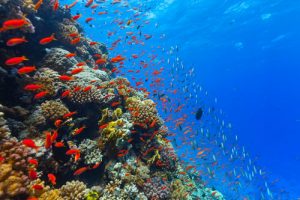The worlds coral reefs are some of the most biologically diverse and economically valuable eco-systems on the Earth. They provide food, income and protection to billions of people worldwide.
However, the coral reefs, and the millions of sea creatures that call them home, are being threatened by many factors and are in serious danger of disappearing. Invasive species, bleaching, diseases, pollution and global warming are all having a negative impact on our coral reef systems. The rapid decline and loss of these ancient, valuable and complex ecosystems will have a great economic, social and environmental impact not only in the United States, but, worldwide.
With El Nino subsiding, Australian authorities are assessing the damage that bleaching has had on The Great Barrier Reef. Bleaching has impacted roughly 93% of the entire system, which compromises 3,000 or so reefs. Bleaching is caused by coral systems being stressed. They lose the symbiotic algae that live in their tissues, leading to a loss of color.
So far, the results are not looking good. According to Bill Leggat, associate professor with the ARC Centre of Excellence for Coral Reef Studies, the corals they are observing are not only the sickest they’ve ever seen, but some are falling apart. Coupled with the visual surveys, the number of corals impacted and the severity of the stress and the damage that they are seeing, it adds up to a very scary story.
In 1998, then President, Bill Clinton, established the Coral Reef Task Force (CRTF) to protect and conserve coral reefs. CRTF is responsible for mapping and monitoring U.S. coral reefs; researching the causes of coral reef degradation including pollution and over fishing and finding solutions to these problems; and promoting conservation and the sustainable use of coral reefs. As a principle member of the CRTF, and as directed by the Coral Reef Conservation Act of 2000, NOAA has the responsibility to conserve coral reef ecosystems.
By using Satellite imagery and color enhanced photography, the NOAA is to observe sea temperatures all around the world. This helps them see how environmental changes are affecting the coral reefs globally and locally.
Underwater robots created at Rutgers University are helping scientists understand the effects of climate change when it comes to our reef system on a global scale. With the technology now in use to better understand our coral reefs, precision lenses designed and manufactured for specific satellites, will deliver the clearest most precise image possible.
Universe Kogaku designs and manufactures optical lenses for satellite imagery, underwater robotics, security, high tech and electronic applications. We stock 1000’s of standard lens assemblies and can custom design a solution for scanners, CCTV, CCD/CMOS, medical imaging, surveillance systems, machine vision and night vision systems.